Machrihanish Dunes Golf Course - lovingly crafted out of the natural landscape
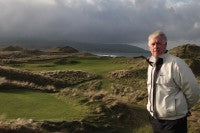 "As with any new golf course, it is an evolving landscape and, often, changes need to be made to improve the condition and playability of the course"
"As with any new golf course, it is an evolving landscape and, often, changes need to be made to improve the condition and playability of the course"
A chance meeting with Jimmy Kidd at a Golf Awards dinner last January, was the opportunity to set myself up for a visit to see one of the most talked about new golf courses in Scotland. Highly regarded as having some of the best links golf courses in the world, I was interested to find out more about Machrihanish Dunes, especially, as the course had recently gained the coveted GEO certification and won the STRI's Waste Management award. A great achievement considering the course is less than three years old.
Jimmy was keen for me to come and see for myself the work achieved in such a short time and, so it was that, in the first week of November 2011, working around a fleeting visit to Scotsturf, I chose to take the drive from Edinburgh, heading north of Glasgow along the Bonnie Banks of Loch Lomond, past Inverary Castle on the shores of Loch Fyne - the home of the Duke of Argyll, head of Clan Campbell - and on to Campbeltown. Taking in some breathtaking views, and finally arriving at the village of Bellochantuy on the Mull of Kintyre, where I met up with Jimmy, who lives here for a large part of the year.
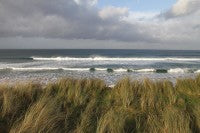 Jimmy's home overlooks the Atlantic ocean and, as well as being a perfect location for a 'true Scot' to live, enables him to be close to Machrihanish Dunes, just five miles away.
Jimmy's home overlooks the Atlantic ocean and, as well as being a perfect location for a 'true Scot' to live, enables him to be close to Machrihanish Dunes, just five miles away.
Jimmy, and his son David McLay Kidd, have a vested, part ownership, interest in the club. David was the golf architect who designed the course, with his senior designer, Paul Kimber, on site throughout the construction process and liaising with all of the environmental professionals on this most sensitive site for links golf.
Both Jimmy and David have a long association with golf. At the age of fifteen, having never even picked up a golf club, Jimmy took a job as an apprentice greenkeeper at Ranfurly Castle Golf Club in his home village of Bridge of Weir, Scotland. Within six short years, he had worked his way up to Head Greenkeeper of the Killermont course at the Glasgow Golf Club - the fifth oldest golf club in the world, having been instituted 1787.
In 1982, Jimmy was offered one of the most prestigious job positions in Scotland, as Estates and Golf Courses Director at the Gleneagles Resort. During twenty-one years, Jimmy prepared Gleneagles courses for seventeen championships, including eight consecutive PGA European Tour Bell's Scottish Opens, and was the first to be awarded the Pan European Certificate for Environmental Excellence.
He played an integral role in the successful bid to bring the 2014 Ryder Cup to Gleneagles. He also served as a consultant at the 2000 President's Cup matches, working with the PGA of America as a consultant to and representative of the hosts, Fancourt Resort in South Africa.
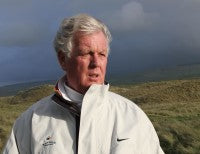 Jimmy subsequently spent three years as Director of Golf Operations at the exquisite Sandy Lane Resort on Barbados, where he grew in The Green Monkey Course, which was, in 2005, awarded the Golf Digest Best Course in the World to Play, and prepared the Country Club course for the World Cup of Golf in 2006 and, if that wasn't enough, also coordinated the first Caribbean Golf Turf Maintenance vocational qualification.
Jimmy subsequently spent three years as Director of Golf Operations at the exquisite Sandy Lane Resort on Barbados, where he grew in The Green Monkey Course, which was, in 2005, awarded the Golf Digest Best Course in the World to Play, and prepared the Country Club course for the World Cup of Golf in 2006 and, if that wasn't enough, also coordinated the first Caribbean Golf Turf Maintenance vocational qualification.
Jimmy's son, David, was born and raised in the Scottish lowlands, and his route into the golf industry was somewhat different to his father. His formal education came at Writtle College. He then completed an internship with Southern Golf, a leading golf course construction company, before joining Swan Golf Designs as a designer/project manager. In 1991, at the age of 24, David returned home to work as Director of Design for Gleneagles Golf Developments (GGD), a post he would hold until 1999.
David's belief that his working methods need to be flexible and site-specific became ingrained whilst working as the principal architect for GGD, for whom he designed and completed a number of courses across three continents, notably Gokarna Park Golf Resort, Kathmandu, Nepal; Golf De Andratx, Majorca, Spain; and Bandon Dunes, Oregon, USA.
In 1998, upon completion of Bandon Dunes, David struck out on his own and established DMK Golf Design, with father Jimmy drafted in as Director and Consultant on all agronomic matters.
How Machrihanish Dunes came into being
David has always known Machrihanish as a special place, having spent many holidays at the family's summer home. Here he would run along the sandy beach and hide amongst the dunes, but it wasn't until the late 1980s that he and his father initially discussed the possibility of creating a golf course amongst the virgin dunes.
As his career flourished through the nineties, and his reputation for designing stunning courses grew, the dunes of Machrihanish were never far from his mind but, even as he was seeking potential investors for the project, a second group had begun to take interest in the site.
 As far back as the 1970s, photographer Brian Morgan had become instantly drawn to the area. After becoming friends with developer, Brian Keating, towards the turn of the century, Morgan brought him to see the site. Keating loved the idea, and the two friends decided it was the perfect setting to create the world's next great links course in Scotland.
As far back as the 1970s, photographer Brian Morgan had become instantly drawn to the area. After becoming friends with developer, Brian Keating, towards the turn of the century, Morgan brought him to see the site. Keating loved the idea, and the two friends decided it was the perfect setting to create the world's next great links course in Scotland.
In 2001, Morgan and Keating approached the Barr family, the owners of the land, and struck a deal to work on the potential project. As primary backer of the endeavour, Keating took charge of the project. He planned to move forward and hired a course architect to draw up preliminary plans.
At the same time, David had decided to develop a new course in Machrihanish with his own funding, but was shocked to find that someone else had got there before him. Realising that his childhood dream was about to be fulfilled by someone else, he became determined to join the project as course architect. He discovered that the contract with the course architect had not been cemented, and immediately put together a presentation for Keating and Morgan.
Upon meeting David, it quickly became obvious to Keating and Morgan that here was a man who, with his close association to the area, was the perfect fit to fulfil their vision and, so, the crucial role of golf course architect was entrusted to him.
How the course was built
With a development team in place, the real challenges and rewards began to accrue. Scottish Natural Heritage, tasked with protecting the natural beauty of Scotland, was wary about allowing course development on a Site of Specific Scientific Interest. This area is under particular scrutiny as it is the home of five rare types of orchid,  two of which are on the endangered list.
two of which are on the endangered list.
It was only after the developers and designer clearly demonstrated how the golf course would actually help the land flourish that construction was allowed to begin. In an effort to respect the land, minimal shaping of the course was undertaken. Whilst greens and tees were slightly moulded, the rest of the course was simply 'uncovered' and mown down by hand.
David identified twenty-three 'natural' holes, of which he chose the eighteen that would best suit the overall layout. To limit disturbance, areas that suffered from sheep and extensive rabbit damage were used as bunkers, similar to the way bunkers originally evolved on courses hundreds of years earlier.
Gentle hand-mowing was carried out to create the fairways that had, essentially, been 'hiding' there since the dunes were formed countless years earlier. The project moved along smoothly, with most work being carried out by hand. No heavy machinery was allowed to be used, and only a backhoe was utilised to shape the greens and tees.
Euan Grant, Keeper of the Green at The Old Course, St. Andrews, joined the project in 2007, helping to ensure an excellent grow-in phase. After a very successful stint at Machrihanish Dunes, Euan was given the honour, in 2009, of preparing Turnberry for the 2009 Open Championship. His first assistant, Keith Martin, stayed on at Machrihanish Dunes, taking over as Keeper of the Green. Keith began his greenkeeping careers at Reaseheath College back in 1993, where the inimitable Dennis Mottram was his tutor.
Current management arrangements
Machrihanish Dunes Golf Club, and the luxury accommodations in both Machrihanish and Campbeltown, is now managed by Southworth Europe Limited, a subsidiary 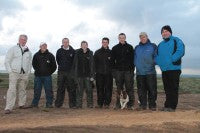 of Southworth Development LLC, a privately held company based in Newton, Massachusetts. The company, which specialise in the development of residential resort and hospitality branded real estate communities, has an equity stake in the complex.
of Southworth Development LLC, a privately held company based in Newton, Massachusetts. The company, which specialise in the development of residential resort and hospitality branded real estate communities, has an equity stake in the complex.
Through its subsidiaries, Southworth Europe Limited and Southworth Golf, the company is also extremely active in the international golf industry.
Southworth Golf's management operations specialise in the management of multi-faceted, full-service properties, often located within destination resort developments. The company's philosophy is to operate properties as individual brands, with most business and personnel practices customised to each property's specific market.
In addition to the Machrihanish and Campbeltown projects, Southworth's management contracts include Costa Caribe Golf & Country Club in Ponce, Puerto Rico; Creighton Farms in Aldie, Virginia; Meredith Bay on Lake Winnipesaukee, New Hampshire; and Renaissance Golf Club in Haverhill, Massachusetts.
Walking the course
 The morning after an evening of fine food and reminiscences, I was treated to a tour of the course.
The morning after an evening of fine food and reminiscences, I was treated to a tour of the course.
Jimmy was keen for me to see how well the course had been laid out; making good use of the natural topography of the site, and explained how David's team worked closely with Scottish Natural Heritage to ensure no environmental damage was caused during its landscaping.
Keith, recently promoted from Keeper of the Greens to Director of Golf, went on to explain how the club work hard to meet the Potential Damage Objectives set by Scottish Natural Heritage. These include a ban on chemicals, imported topdressings or unapproved seed varieties, and a restriction on certain working practices on any part of the course, other than greens and tees. Here, Keith and his greenkeeping team can reasonably do what they wish in terms of maintenance operations on these areas.
"It has been a case of building up a good working relationship, and gaining the trust of Scottish Natural Heritage," explained Keith. "For example, all our topdressings are restricted to materials found on site. The team collect seaweed from the beach, mix it with grass clippings and sand from the dunes. This is left to compost down and then used eighteen months later."
"As with any new golf course, it is an evolving landscape and, often, changes need to be made to improve the condition and playability of the course to meet our guests' requirements," explained Keith. "We were particularly concerned about three of our greens - the 6th, 8th and 17th - and it is only after listening to feedback from visiting golfers, plus our own observations, that we are able to act. In these three instances, our aim was to increase the number of available pin locations, and to improve bunker strategy and playability of the holes whilst, at the same time, taking the opportunity to solve some problems of sodium rich beach sand blowing on to the 6th green, in particular. With the course's reputation growing, increased numbers of visiting golfers are forecast for 2012, so making these changes now is simple common sense."
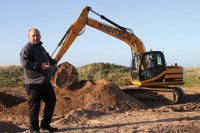 "The rebuilding of greens can often be fraught with problems, with the weather often dictating progress, especially in this corner of Scotland. However, we have been blessed with near perfect weather - little or no wind and bright sunshine. The process was a fairly simple one; strip off the existing turf, put it to one side, excavate and remodel the new green. The old turf was used for target greens on the range, outside of the SSSI, with a new bent/fescue mix turf, supplied by Tillers Turf, used for the replacement greens."
"The rebuilding of greens can often be fraught with problems, with the weather often dictating progress, especially in this corner of Scotland. However, we have been blessed with near perfect weather - little or no wind and bright sunshine. The process was a fairly simple one; strip off the existing turf, put it to one side, excavate and remodel the new green. The old turf was used for target greens on the range, outside of the SSSI, with a new bent/fescue mix turf, supplied by Tillers Turf, used for the replacement greens."
Keith's team of five, Head Greenkeeper, Kevin Smith, and greenkeepers Hugh McPhee, Chris Grogan, Sebastion Zuruwaski and Craig Barr, carried out the work, with the assistance of a local back hoe operator, overseen by Keith, Jimmy and Greg Sherwood of Southworth Developments.
Keith's greenkeeping team is complemented by mechanic, Lucas Mati, and landscape gardener, Stewart Graham.
As well as remodelling the greens, the team is also revetting the leading edges of the mainly marram grass 'blow out' style bunkers. It was interesting to see how quickly the work was achieved by a dedicated team of young greenkeepers, none of whom had tackled such bunker face works before.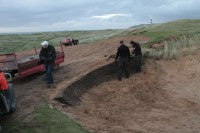
Day to day maintenance
The greens are maintained at 4mm in the summer and are raised to 5.5mm for the winter. They are hand cut daily during the growing season using Toro 1000 mowers and, in the winter, Toro Flex21 triple mowers tend to be used. Surrounds are cut with Toro triples and maintained between 9-12mm. Green speed is kept between 9.5-11 feet, depending on the time of the year and weather conditions.
"We use a turf iron to help firm up the greens, and pin positions are usually changed twice a week," said Keith. "We have instigated a balanced feeding programme to maintain colour and vigour, using a combination of organic and synthetic products. We are currently trialing compost tea, along with Mol turf, a natural carbohydrate booster and soil microbe activator developed by The Great Turf Company."
"With the greens built on the natural sands, leaching of nutrients is fairly high. So, to help reduce the calcium lock up, a regular dose of potassium is also applied," continued Keith.
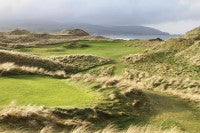 "All our tees are hand mown as they are difficult to access with larger machinery. We maintain a height of cut around 12mm. Feeding and aeration programmes are the same for greens and tees. We use a vertidrain twice a year, along with some solid tining and hydrajetting to maintain porosity in the greens and tees. Thatch is not too much of a problem, with less than 2% found in the greens and tees. Ideally, we would like about 4-5% thatch. That would give the greens a bit of protection and moisture holding capacity."
"All our tees are hand mown as they are difficult to access with larger machinery. We maintain a height of cut around 12mm. Feeding and aeration programmes are the same for greens and tees. We use a vertidrain twice a year, along with some solid tining and hydrajetting to maintain porosity in the greens and tees. Thatch is not too much of a problem, with less than 2% found in the greens and tees. Ideally, we would like about 4-5% thatch. That would give the greens a bit of protection and moisture holding capacity."
Greens and tees are serviced by a fully automated pop up watering system.
Keith is trying to increase the amount of colonial bent within the original pure fescue greens; this being achieved with a robust overseeding programme using a Blec seeder.
Fairways are maintained at 14mm using a Toro 5140 triple mower. "We generally cut twice a week, and control weeds by mowing and light verticutting to thin the leaves, make them more upright to integrate them into the indigenous grass sward, creating a natural and more than acceptable playing surface," said Keith.
"As previously explained, we are not allowed to use chemicals but, with Scottish National Heritage's blessing, we were allowed to use weed wipes to control ragwort and thistles in the rough but, in the main, these are controlled by hand weeding."
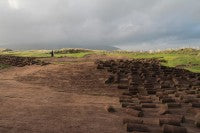
"Clippings are generally collected off the fairways, but we do have permission, at times, to allow them to fly to put some nutrients back."
Throughout the year, thirty Black Orkney sheep roam the course controlling the softer grass species, and these have been adopted as the logo of this aspiring golf course operation.
During the winters of 2007, 2008 and 2009, the Orkney sheep were joined by over three hundred other sheep to help graze the fairways and rough. Electric fences were rigged up to protect the greens. Additional sheep grazing will take place this winter, but will be restricted to specific areas.
Annual rainfall is around 1200cm and temperatures remain mild for most of the winter, due to the Gulf Stream warming the adjacent Machrihanish Bay and Kintyre coastline. The evidence of this micro climate can been seen with palm trees growing in the surrounding villages.
What next for Machrihanish Dunes?
With the owners having flown in from Boston for an update on the progress of the project, both out on the course and the redevelopment of two hotels they also own, it is clear to see that there is serious financial commitment to this stunning part of Scotland.
 The two hotels - the Royal Hotel, close to the harbour in Campbeltown and the Ugadale in Machrihanish - will, once completed, provide jobs for over one hundred local people, as well as providing four star facilities for people wanting to stay and play golf in the area.
The two hotels - the Royal Hotel, close to the harbour in Campbeltown and the Ugadale in Machrihanish - will, once completed, provide jobs for over one hundred local people, as well as providing four star facilities for people wanting to stay and play golf in the area.
The area is easily reached by daily flights from Glasgow airport into Campbeltown airport, which has one of the longest runways in Europe, at over two miles long. This was built as an emergency landing site for the space shuttle. The airfield was a base for the US Airforce for many years but, today, the outbuildings serve as a manufacturing base for wind farm windmills and allied equipment, which are shipped from the town's harbour all over Europe.
Campbeltown airport enables visitors to access the golf resort destination quickly and easily (not by shuttle, obviously) and, as well as Machrihanish Dunes, the Mull of Kintyre boasts three other excellent courses; The Machrihanish Golf Club, an old Tom Morris design instituted in 1896; Dunavety Golf Club, home of Belle Robertson, Ladies British Amateur Champion and Curtis Cup player; and Carradale Golf Club, a nine hole course on the South Eastern tip of this the most westerly peninsula in Scotland.
Once Jimmy was happy that I had all the information I needed, and that the green shaping and bunker work was progressing well, he took me on a sightseeing tour, including the hotel in Campbeltown and a visit to the Dunavety Golf Club. Before long the sun was setting over the dunes, leaving me to take some breathtaking pictures over the Machrihanish Dunes and Westport beach; a scintillating five mile stretch of golden sand.
I cannot thank Keith and Jimmy enough for putting up with me, especially during a busy time. There is no doubt in my mind (a rarity. Ed.) that this course will feature high on the list of 'must visit' golfing destinations in the coming years.
It may be a bit off the beaten track, but well worth the visit and, if you have the time, take the drive down the peninsula rather than the flight. No wonder Paul McCartney waxed so lyrical about the place.
The condition of the course is a testament to the commitment and skills of Keith and his greenkeeping team and, with Jimmy's vast experience to call on, the venture is in good hands.
The future of the course looks bright; the owners should be proud of what everyone has achieved, and must be congratulated for their major financial investment in this project, especially when the current economic climate is so poor for golf development. They have brought a lot of hope to the residents of this peninsula in securing some much needed employment opportunities, and have created a truly breathtaking addition to this picturesque golf destination.
